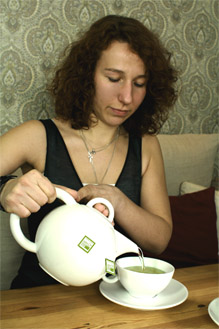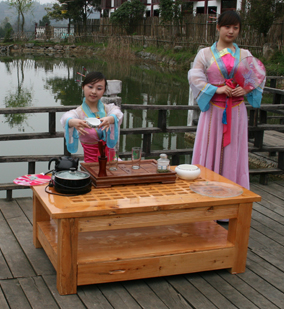Information about tea
There are many possibilities and individual preferences when it comes to the preparation of tea. For our Ziran Premium Green Tea we suggest the following procedure: Bring fresh cold water to a boil. Using hot tap water will lead to a cloudiness of the tea. Let the boiling water cool down for 2-3 minutes to a temperature of about 85°C. Pre-warm your teapot or cup with hot water. Do this by filling it with a bit of hot water, then pour it out again. Place the pyramid bag into the cup or the teapot (use 2 bags for a pot) and pour the hot water over it. Let the tea steep for 2-3 minutes. Then - enjoy! |  |
If you have trouble remembering these steps just think about the 3 easy Ziran golden rules:
3 minutes to allow boiled water cool down
3 minutes to let the tea steep, which yields
3 infusions to enjoy
Some folks choose not to remove the tea after steeping. This sometimes will create a somewhat bitter taste. Although, with teas of high quality - such as Ziran Premium Green Tea - this effect is, if at all, not very strong. You may use our teas up to 3 times. Each brew offers a slightly different aroma: initially tender and fresh, then aromatic and sweet. One can drink tea for many reasons - enjoyment, health, or simply for the pleasure of its leisure. Each of them can make tea consumption a daily part of one’s life. And Zhuang Zi, one of the creators of Taoism, stated long ago: "Only things that are consistent with the rules of nature are in harmony, truly good and beautiful.”
China’s tea culture continues to develop and has ever since had an immense impact on the global art of making tea. Today this includes more than just the advances in production processes and the expansion in variety. It also includes growing knowledge as well as modern and popular ways of preparing tea. The enjoyment factor is becoming more and more popular and widespread - though it has been an essential part of tea culture long since, as the tea master Zhu Quan (1378-1448) states: "A pleasant breeze strikes towards you and you feel as if heaven and earth breathe serenity. After drinking seven cups, you feel like having wings and float light as an angel in heaven. "
|  |
Green tea has a long history leading back to a Chinese legend which is said to have taken place in year 2737BC. The legend goes that the discovery of tea occurred by mere coincidence. The great Chinese Emperor Shen Nong was travelling around when he approached a tree and decided to stay there. Due to his cleanliness he drank his water only after it had been distilled and therefore still warm at times. One day as he was holding a bowl of warm water in his hands, the wind blew off some leaves from a nearby tea, which coincidently fell into his drink. Curious about the color and aroma of his water, Emperor Shen Nong decided to try it only to find that he was very impressed by the taste. This may be the story of the first tea to have been drunk. |  |
It isn't until the Tang Dynasty (618-907AD) that tea finally arrived to the imperial court as a favourable choice of consumption. On the same note, Buddhist monks began to savour the teas invigorating refreshment from extensive meditation, which was often quite exhausting. It wasn't too long before they began to cultivate tea in cloister gardens themselves. In the year 760AD, the world's first book on tea, "Book of Tea," was written by Lu Yu. In his book, he describes details on the production and growth of tea and suggests locations that are best for growing tea. To no surprise had Lu Yu rightfully earned himself the nickname, "God of the tea." At this point, tea's popularity and demand had widened, and China started exporting tea to other countries such as Japan and Korea.
For several hundred years the consumption of tea had been reserved for only the imperia. Due to its monetary, spiritual and dietary value, tea was considered too precious and much too expensive for the common people to acquire. Eventually, an ascendance of upper-class citizens made the demanded tea more abundant on the market. Thus, the event became more widespread and appreciated.
There were several types of processing methods in the preparation of green tea. For example, it was pressed and formed into small bricks, pulverized and then diffused in warm water using a small bamboo whisk. At the time of the Yuan Dynasty (1279-1368AD) tea was much more available to the common people and was being consumed among the entire population. The original method of pouring hot water over tea leaves became the most common preparation technique. Still today, it is the most well-known and popularly used type in China. Even Lu Yu was convinced that people should enjoy green tea as naturally as possible.
It was not until 1610 that tea arrived in Europe when the Dutch shipped in stocks of tea. Eventually, this spread by trade to Germany and France. Much later, about 60 years later, the English joined in on the tea business and began to grow tea in their colonies. |  |
antioxidants - Natural molecules which fight off free radicals and help to protect the body cells. Green tea is exceptionally rich in antioxidants.
essential oils - Volatile, oily extracts that give green tea its basic flavor.
components - Important ingredients of tea plants. Green tea is well-known for a number of natural ingredients, such as caffeine and tannin which together provide a refreshing, invigorating effect.
leaf tea - Tea of the whole and unbroken leaf.
oxidation - In the past often misleadingly called "fermentation". By bruising the leaves and breaking the cell walls in it, plant juices are released and naturally oxidize with the air. This is an essential step in the production of black tea. Whereas in the production of green tea the oxidation is stopped.
first flush - Tea plucked during the first tea harvesting season of the year in springtime. It is the highest of its grade. Its tender leaves are especially rich and offer an exceptionally delicate flavor.
tannins - Important ingredient of tea, a polyphenol. An anti-inflammatory and provides a soothing effect to mucous membranes.
green tea - In contrast to black tea, green tea does not undergo oxidation in its processing.
caffeine - Caffeine is an important component especially of green tea (also known as "theine") and increaces heart rate and circulation. The stimulating effect of caffeine found in tea is gentler and healthier than the caffeine found in coffee. The effect starts a bit later, is more gradual and balanced and also continues for a longer period.
storage - Especially high quality loose leaf tea should be kept in a dry, dark and cool place. If possible, stored away from aromatic foods, especially spices. Taking into account that the inherent aroma and flavoring of the tea may be affected.
organic tea - Tea grown under the restrictions of organic farming (esp. the IFOAM norms).
polyphenols - Also known as flavonoids. Are anti-inflammatory that protects body cells against free radicals.
pyramid bag - A pyramid-shaped tea pouch which allows enough room for tea leaves to fully unfold their qualities.
second flush - The second harvest of the year. In China, between June and August.
tea plant – Camellia sinensis var. sinensis was first cultivated in China. Camellia sinensis var. assamica is grown mainly in India and Sri Lanka. Both original varieties have been crossed and hybrids bred.
vitamins - Especially green tea contains many of the natural vitamins of the tea plant, such as Vitamin A and B.
 Deutsch
Deutsch English
English
